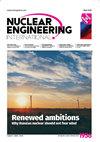Scaling Analysis of AP600 Long Term Cooling Performance
IF 0.6
4区 工程技术
Q4 Engineering
引用次数: 0
Abstract
Westinghouse’s AP600 thermohydraulic design, with passive safety features, poses new challenges to computer simulation and analyses, the design of experimental test facilities to represent it, and to the proper interpretation of the data from these facilities. The conventional approach of modeling the reactor thermohydraulic system as a closed, steady state, natural circulation loop from which non-dimensional groups of parameters can be derived and used in the design of integral tests, is limited and can not capture the abrupt time-varying open system nature of the new design. A rigorous and systematic, eight-step methodology has been developed to scale and interpret the results from three different integral test facilities, and to relate them to the full scale plant. In this paper, the aforementioned scaling methodology is applied to the analysis of the long term cooling phase of the AP600 behavior. This long term cooling phase, which appears independent of the initiating event, is divided for its analysis into two sub-phases. A first sub-phase dominated by the draining of the large In-Containment Refueling Water Storage Tank through the primary systems, and a second sub-phase characterized by the quasi-steady recirculation of coolant through the reactor vessel and the outside of the primary system. The analysis shows that with a few verifiable assumptions one can determine the key parameters and non-dimensional groups that govern the behavior in either of these sub-phases. One then uses these parameters and non-dimensional groups to evaluate the relevancy of existing test data.AP600长期冷却性能的结垢分析
西屋公司的AP600热液压设计具有被动安全特性,对计算机模拟和分析、实验测试设施的设计以及对这些设施数据的正确解释提出了新的挑战。传统的反应器热液压系统建模方法是一个封闭的、稳态的、自然循环回路,从中可以导出无量纲参数群并用于积分试验设计,这种方法是有限的,不能捕捉新设计的突然时变开放系统的性质。一个严格和系统的八步方法已经被开发出来,用于扩展和解释来自三个不同的整体测试设施的结果,并将它们与全规模工厂联系起来。本文将上述标度方法应用于AP600长期冷却阶段的行为分析。这个长期的冷却阶段,似乎独立于初始事件,被分为两个子阶段进行分析。第一个分阶段主要是通过主系统排出大型的安全壳内换料储存罐,第二个分阶段的特点是冷却剂通过反应堆容器和主系统外部的准稳定再循环。分析表明,通过一些可验证的假设,可以确定控制这两个子阶段行为的关键参数和无量纲群。然后使用这些参数和无维组来评估现有测试数据的相关性。
本文章由计算机程序翻译,如有差异,请以英文原文为准。
求助全文
约1分钟内获得全文
求助全文
来源期刊

Nuclear Engineering International
工程技术-核科学技术
自引率
0.00%
发文量
0
审稿时长
6-12 weeks
期刊介绍:
Information not localized
 求助内容:
求助内容: 应助结果提醒方式:
应助结果提醒方式:


